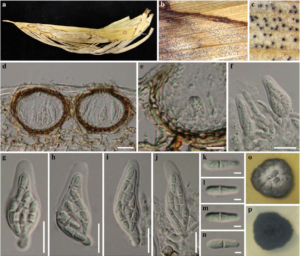Zasmidium musae (Arzanlou & Crous) Crous & U.Braun., Schlechtendalia 20: 102 (2010)
≡ Stenella musae Arzanlou & Crous, Persoonia 20: 31 (2008)
Index Fungorum number: IF516587, Facesoffunginumber:FoF 00440; Fig. 1
Biotrophic or hemibiotrophic causing necrotic leaf spots on palms. Lesions initially small, globose to subglobose, becoming irregularly broader lesions, dark brown to reddish-brown at the margin, dry, pale brown at the centre. Sexual morph Ascomata 50 – 60 μm high, 60 – 75 μm diam., scattered, solitary to gregarious, immersed to semi-immersed, with protruding papilla, visible as black spots on host surface, uniloculate, globose to subglobose, glabrous, ostiole central, with minute papilla, rounded at the apex. Peridium 5 – 11 μm wide, thinwalled, of equal thickness, comprising 3 – 7 cell layers of brown to dark brown, pseudoparenchymatous cells, arrenged in a textura angularis . Hamathecium lacking pseudoparaphyses. Asci (26.5–) 27 – 33 (–36) × 9 – 12 μm (x̄ = 31.9 × 10.9 μm, n = 25), 8 – spored, bitunicate, fissitunicate, ampulliform to ovoid, with subsessile to knob-like pedicel, pically rounded, with well-developed ocular chamber, thick-walled at the apex. Ascospores 8 – 10 × 2 – 3 μm (x̄ = 9.5 × 2.7 μm, n = 30), irregular overlapping 1 – 4-seriate, oblong to clavate, hyaline, 1 – septate, not contricted at the septa, wall smooth to rough, thick-walled, mostly upper cell wider than lower cell. Asexual morph Undetermined.
Culture characters – Colonies on MEA slow growth, 24 – 25 mm diam. after 3 weeks at 25 – 30 °C, dark greenish to dark grey at the margin, white to pale grey at the centre; reverse dark greenish to black; dense, irregular, raised, rough with entire edge, glabrous to velvety, radially furrowed.
Material examined – THAILAND: Chiang Mai, San Sai District, Maejo University, on living leaves of palm, 18 July 2010, R. Phookamsak RP0048 (MFLU11–0168), living culture, MFLUCC 11–0132. GenBank ITS: KP744472; LSU: KP744514; SSU: KP753970.
Notes – Zasmidium musae (Arzanlou & Crous) Crous & U. Braun was described as Stenella musae Arzanlou & Crous based on its asexual morph and lack of known sexual morph (Arzanlou et al. 2008). Based on a megablast nucleotide search in GenBank of the ITS sequences, our isolate is identified as Stenella musae and the pariwise comparison of ITS shows that our isolate and Z. musae differ only in one base pair. Based on phylogenetic analysis of LSU gene data, our isolate forms a clade clustered with Zasmidium scaevolicola. Therefore, we report the sexual morph of Zasmidium musae.

Fig. 1 Zasmidiummusae (MFLU11–0168) a-c Ascomata visible as black spots on leaf lesions. d Vertical section through an ascoma. e Peridium. f–j Asci. k–n Ascospores. o, p Culture characteristic. Scale bars: d = 20 μm, e – j = 10 μm, k – n = 2 μm.
